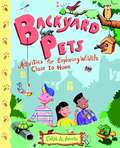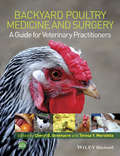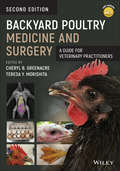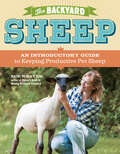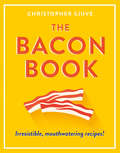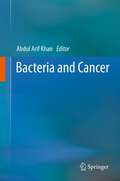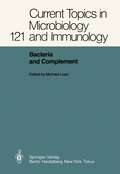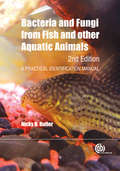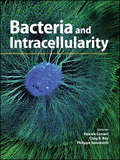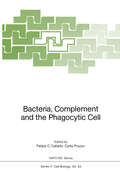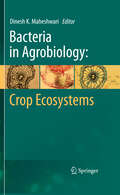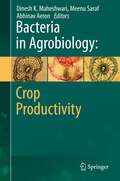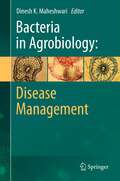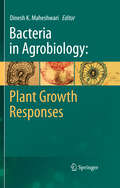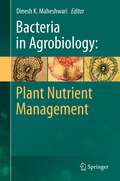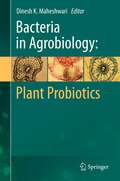- Table View
- List View
Backyard Pets: Activities for Exploring Wildlife Close to Home
by Carol A. AmatoGet to know the amazing creatures right outside your door! What do toads like to eat? Why do crickets sing? Why does a firefly glow? If you've ever longed to know more about the habits of the animals and insects that live in your backyard, here's the book you've been waiting for! With Backyard Pets, you'll find out how to catch and care for lots of different, easy-to-find critters, from terrific toads to slithering slugs. You'll perform all sorts of investigations and activities, including discovering how snails eat and how caterpillars protect themselves, before you return your newly found pets safely to their natural home. And you'll even find out how to attract birds and butterflies to homemade feeders and gardens so that you can observe them every day as they go about their amazing lives. As you take care of your pets, you'll learn how to interpret fireflies' signals; how to entice worms from their burrows with sound; and how to make birdfeeders, hummingbird gardens, and toad abodes. Along the way, you'll discover lots of fascinating facts about the lives of these clever critters-from what their favorite foods are to how they see, hear, and move, and even how they help the environment.
Backyard Poultry Medicine and Surgery: A Guide for Veterinary Practitioners
by Cheryl B Greenacre Teresa Y MorishitaBackyard Poultry Medicine and Surgery is a practical resource offering guidance on developing diagnostic and treatment plans for individual companion poultry or small flocks. Organized by body system to aid in developing a differential diagnosis list for common presenting signs, the book provides all the information clinicians need to effectively treat backyard poultry. Written by experts from both the commercial poultry field and the companion avian field, the book provides thorough coverage of both common and less common diseases of backyard chickens, ducks, and other poultry. The book begins with introductory chapters covering general information, an overview of US laws, and basic husbandry concerns, then moves into specific disease chapters organized by system. The book takes an individual medicine perspective throughout, with photographs, radiographs, and histopathological photomicrographs to illustrate principles and diseases. Backyard Poultry Medicine and Surgery is an invaluable guide to diseases and treatments for any practitioners treating backyard poultry.
Backyard Poultry Medicine and Surgery: A Guide for Veterinary Practitioners
by Cheryl B. Greenacre Teresa Y. MorishitaBackyard Poultry Medicine and Surgery is a practical resource offering guidance on developing diagnostic and treatment plans for individual companion poultry or small flocks. Organized by body system to aid in developing a differential diagnosis list for common presenting signs, the book provides all the information clinicians need to effectively treat backyard poultry. Written by experts from both the commercial poultry field and the companion avian field, the book provides thorough coverage of both common and less common diseases of backyard chickens, ducks, and other poultry. The book begins with introductory chapters covering general information, an overview of US laws, and basic husbandry concerns, then moves into specific disease chapters organized by system. The book takes an individual medicine perspective throughout, with photographs, radiographs, and histopathological photomicrographs to illustrate principles and diseases. Backyard Poultry Medicine and Surgery is an invaluable guide to diseases and treatments for any practitioners treating backyard poultry.
Backyard Poultry Medicine and Surgery: A Guide for Veterinary Practitioners
by Cheryl B. Greenacre Teresa Y. MorishitaBackyard Poultry Medicine and Surgery, Second Edition is a thorough revision and expansion of the first book to provide practical information for veterinarians treating individual or small flocks of poultry. With seven new chapters covering toxicology, euthanasia, gross pathology, behavior, game bird medicine, vaccinations, and drugs, and many existing chapters significantly expanded, the book offers a complete guide to all aspects of husbandry, medicine, and surgery for backyard poultry. Organized by organ system for ease of use, the book is designed to support veterinarians in diagnosing and treating backyard chickens, whether they see an occasional bird or regularly treat poultry. More than 400 color photographs aid in breed identification and diagnosis, and the clinical focus enables veterinarians to confidently and knowledgably develop a diagnostic and treatment plan. Chapters are written by leading experts in avian medicine and surgery. Backyard Poultry Medicine and Surgery is a must-have reference for any veterinarian called on to care for backyard flocks, whether they see an occasional chicken or treat poultry regularly. Offers a comprehensive guide to diagnosing and treating backyard poultry Presents practical information on husbandry, medicine, and surgery Written from an individual medicine perspective to aid practitioners in developing a diagnostic and treatment plan for the individual or small flock of poultry Expands significantly on the first edition, with many expanded chapters and seven brand-new chapters Includes new chapters covering toxicology, euthanasia, gross pathology, behavior, game bird medicine, vaccinations, and drugs Provides more color photographs to aid in breed and disease identification
Backyard Poultry Medicine and Surgery: A Guide for Veterinary Practitioners
by Cheryl B. Greenacre Teresa Y. MorishitaBACKYARD POULTRY MEDICINE AND SURGERY An expanded edition that explains the diagnosis and treatment of backyard poultryYou can look to Backyard Poultry Medicine and Surgery, Second Edition for practical veterinary information on the treatment of poultry. You’ll find six new chapters covering radiology, toxicology, euthanasia, gross pathology, behavior, and emergency medicine. The book is written by some of the most respected specialists in a broad range of fields.With many original chapters also significantly expanded, the book provides a complete guide to all aspects of husbandry, medicine, and surgery for poultry. Diseases are organized by body systems to aid in developing a diagnosis. This book supports your work as a practitioner, whether you treat birds occasionally or regularly.Review information on the topics of husbandry, medicine, and surgeryGain guidance on developing a diagnostic or treatment plan for the individual or small flock of poultryChoose appropriate doses of labeled and extra-label drugsFind new chapters on emergency medicine, toxicology, euthanasia, gross pathology, normal and abnormal radiographic findings, and other key topicsUse color photographs to aid in breed identification and poultry disease diagnosesView photographs, videos, and linked references and websites on an accompanying websiteThis is an essential and comprehensive guide providing enhanced and updated information to support all types of practitioners—from the dedicated avian veterinarian to those who rarely treat these species.
The Backyard Sheep: An Introductory Guide to Keeping Productive Pet Sheep
by Sue WeaverRaise a flock of sheep in your backyard. Even with a limited amount of space, you can enjoy homegrown fleece and fresh milk, as well as the endearing company of these family-friendly animals. Sue Weaver provides all the instructions you need for selecting a breed; housing and feeding; harvesting fleece; and milking. With simple recipes for making cheese and yogurt, and tips on processing fleece for wool, you&’ll enjoy the varied and numerous rewards of keeping sheep.
The Bacon Book: Irresistible, Mouthwatering Recipes!
by Christopher SjuveThe perfect gift for the bacon lover in your life packed with creative ways to pig out.
Bacon Nation: 125 Irresistible Recipes
by Peter Kaminsky Marie RamaEverything tastes better with bacon. One of those flavor-packed, umami-rich, secret-weapon ingredients, it has the power to elevate just about any dish, from soups to souffle´s, braises to bread pudding.Peter Kaminsky and Marie Rama know just how to employ it. Peter is the author of both Pig Perfect—a paean to the noble swine—and, most recently, Culinary Intelligence, which argues that the healthiest way to eat is to eat less but really well. He and Marie know that adding irresistible bacon transforms an ordinary dish into an extraordinary one.Bacon Nation is a bacon-lover’s dream, a collection of 125 smoky, savory, crispy, meaty, salty, and sweetly sensuous recipes that go right through the menu. Starters like Spiced Nuts with Bacon; Bacon and Butternut Squash Galette; Bacon, Pear, and Humboldt Fog Salad. Main courses featuring meats—Brawny Bacon Beef Bourguignon, Saltimbacon; poultry—Paella with Chicken and Bacon; fish—Flaky Cod Fillets with Bacon and Wine-Braised Fennel; and pasta, including an update of the classic Roman dish Bucatini all’Amatriciana. Even dessert: Rum Ice Cream with Candied Bacon Chips and Chocolate-Peanut-Bacon Toffee. Or, as Homer Simpson would say, Mmmm, bacon.
Bacteria: A Single Celled Micro-Organism (tactile)
by RnibA cross-section diagram of a single celled micro-organism, showing various parts (cell wall, membrane etc).
Bacteria and Cancer
by Abdul Arif Arif KhanBacterial infections cause substantial morbidity and mortality in cancer patients. These infections always remained enigmatic due to initial reluctance of cancer researchers in understanding their etiologic potential. Etiological association of bacteria with cancer gained credibility after discovery of carcinogenic potential of Helicobacter pylori. Moreover, other suspected associations including Salmonella typhi and gallbladder cancer, Streptococcus bovis and colon cancer, Chlamydia psittaci and ocular adnexal lymphoma and Chlamydia pneumoniae with lung cancer, etc. are looking for a legitimate appraisal to unravel their etiologic potential without prejudice. In contrary, bacteria also show protective role in certain types of cancer. Certain agents derived from bacteria are successfully in practice for the management of cancer. The integrate association of bacteria and cancer is evident in both positive and negative aspects. The role of bacteria in cancer etiology and treatment is vigorously studied since last few years. Present book tries to provide current status of research undergoing in above direction, with the glimpses of future possibility for using microbiological knowledge in the management of this deadly killer.This book will interest specialists dealing with cancer associated infectious complications, researchers working in the field of cancer biology, teachers and scientists in the field of microbiology, biotechnology, medicine and oncology. The unique coverage of bacteriology and cancer association in both positive and negative way can usher into development of novel thrust area for microbiology students and experts.
Bacteria and Complement (Current Topics in Microbiology and Immunology #121)
by Michael LoosDeficiencies in any of the defense mechanisms of the host can lead to severe microbial infections; these are of clinical relevance. Broad up-to-date knowledge in this field allows identification of many unspecific as well as highly specific defense reactions involved in the struggle against infectious diseases. On the other hand, protective structures on the microbial cell surfaces have been adapted and improve the counterpart's chances of survival. In particular, it has been considered that the great diversity of the bacterial envelopes not only determines the anatomical location of the tissue injury but also induces activation of distinct parts of the complex defense system. The specific defense mechanism, whose most prominent constituent is provided by the antibo
Bacteria and Fungi from Fish and Other Aquatic Animals: A Practical Identification Manual
by Nicky BullerThis practical book provides an updated resource for the identification of bacteria found in animals inhabiting the aquatic environment, illustrated with colour photos. It contains expanded biochemical identification tables to include newly identified pathogenic and saprophytic bacteria, molecular identification tests now available for a greater number of aquatic bacterial pathogens, more information on the pathogenesis and virulence of each organism and new coverage of traditional and molecular identification of fungal pathogens and quality assurance standards for laboratories.
Bacteria and Intracellularity (ASM Books)
by Pascale Cossart Craig R. Roy Philippe SansonettiBacteria and Intracellularity clearly demonstrates that cellular microbiology as a field has reached maturity, extending beyond the strictly cellular level to infections of various organs and tissues. Decades of intense investigation into host-bacterial pathogen interactions have highlighted common concepts in intracellularity but also very diverse mechanisms underlying the various infections produced by bacteria. This book offers a wide-ranging look at the latest studies, including: foodborne pathogens, including how, when, and where bacteria interact with the gut and its microbiota infections of the urogenital tract, endothelial barriers, and the nervous system major advances in work with Mycobacterium tuberculosis and M. leprae subcellular microbiology, including metabolism of infected cells, nuclear biology, and microRNAs endosymbionts, in particular the latest work with Wolbachia and its effect on insect transmission of viral pathogens research into cell autonomous defense pathways that has led to major insights into immunology and innate immunity the latest developments in technology, for the next steps in the study of intracellularity All facets of cellular physiology, within the entire scope of cells and host tissues, can be targeted by pathogens. This book offers to researchers, students, and laboratorians a valuable overview of the state of current research into the cellular microbiology of host-pathogen interactions.
Bacteria and Intracellularity (ASM Books)
by Pascale Cossart Philippe Sansonetti Craig R. RoyBacteria and Intracellularity clearly demonstrates that cellular microbiology as a field has reached maturity, extending beyond the strictly cellular level to infections of various organs and tissues. Decades of intense investigation into host-bacterial pathogen interactions have highlighted common concepts in intracellularity but also very diverse mechanisms underlying the various infections produced by bacteria. This book offers a wide-ranging look at the latest studies, including: foodborne pathogens, including how, when, and where bacteria interact with the gut and its microbiota infections of the urogenital tract, endothelial barriers, and the nervous system major advances in work with Mycobacterium tuberculosis and M. leprae subcellular microbiology, including metabolism of infected cells, nuclear biology, and microRNAs endosymbionts, in particular the latest work with Wolbachia and its effect on insect transmission of viral pathogens research into cell autonomous defense pathways that has led to major insights into immunology and innate immunity the latest developments in technology, for the next steps in the study of intracellularity All facets of cellular physiology, within the entire scope of cells and host tissues, can be targeted by pathogens. This book offers to researchers, students, and laboratorians a valuable overview of the state of current research into the cellular microbiology of host-pathogen interactions.
Bacteria and Viruses (tactile)
by Adrian FarnsworthThis is a two page document with four unlabelled images of bacteria and viruses on page one and four unlabelled images of viruses on page two.
Bacteria and yeast
by RnibThis page shows two labelled cell diagrams. There is a locator dot shown, which will be at the top left, when the image is the correct way up. There is a bacterium on the left and a yeast cell on the right of the page. The bacterium has a ribbon of genetic material instead of a nucleus. At the bottom of the page it has three flagella which when waved move the bacterium along. The yeast cell on the right of the page does have a nucleus. The images are not to scale as the yeast cell is approximately three times larger than the bacterium
Bacteria and yeast (large print)
by RnibThis page shows two labelled cell diagrams. There is a locator dot shown, which will be at the top left, when the image is the correct way up. There is a bacterium on the left and a yeast cell on the right of the page. The bacterium has a ribbon of genetic material instead of a nucleus. At the bottom of the page it has three flagella which when waved move the bacterium along. The yeast cell on the right of the page does have a nucleus. The images are not to scale as the yeast cell is approximately three times larger than the bacterium.
Bacteria and yeast (UEB contracted)
by RnibThis page shows two labelled cell diagrams. There is a locator dot shown, which will be at the top left, when the image is the correct way up. There is a bacterium on the left and a yeast cell on the right of the page. The bacterium has a ribbon of genetic material instead of a nucleus. At the bottom of the page it has three flagella which when waved move the bacterium along. The yeast cell on the right of the page does have a nucleus. The images are not to scale as the yeast cell is approximately three times larger than the bacterium.
Bacteria, Complement and the Phagocytic Cell (Nato ASI Subseries H: #24)
by Felipe C. Cabello Carla PruzzoPhagocytic cells and complement are probably the most important components of host defense against bacteria which, after overcoming the mucosal and epithelial barriers, multiply in the subepithelial tissue and may threaten to disseminate and invade the blood stream and different organs. Questions concerning the factors which regulate the interactions of the bacterial cell with host defenses are a challenge to research and lead to practical applications for the prevention, treatment and diagnosis of infectious diseases. The questions of expression and regulation of virulence related bacterial genes and gene products, the specific mechanisms of defence reactions by complement and phagocytic cells, their mutual interactions with bacteria and especially bacterial surfaces are focused. Considerations on how to translate this knowledge into the management of infectious diseases are also included.
Bacteria in Agrobiology: Crop Ecosystems
by Dinesh K. MaheshwariThe future of agriculture strongly depends on our ability to enhance productivity without sacrificing long-term production potential. An ecologically and economically sustainable strategy is the application of microorganisms, such as the diverse bacterial species of plant growth promoting bacteria (PGPB). The use of these bio-resources for the enhancement of crop productivity is gaining worldwide importance.Bacteria in Agrobiology: Crop Ecosystems describes the beneficial role of plant growth promoting bacteria with special emphasis on oil yielding crops, cereals, fruits and vegetables. Chapters present studies on various aspects of bacteria-plant interactions, soil-borne and seed-borne diseases associated with food crops such as rice, sesame, peanuts, and horticultural crops. Further reviews describe technologies to produce inoculants, the biocontrol of post harvest pathogens as a suitable alternative to agrochemicals, and the restoration of degraded soils.
Bacteria in Agrobiology: Crop Productivity
by Dinesh K. Maheshwari, Meenu Saraf and Abhinav AeronThe future of agriculture greatly depends on our ability to enhance productivity without sacrificing long-term production potential. The application of microorganisms, such as the diverse bacterial species of plant growth promoting rhizobacteria (PGPR), represents an ecologically and economically sustainable strategy. The use of these bio-resources for the enhancement of crop productivity is gaining importance worldwide.Bacteria in Agrobiology: Crop Productivity focus on the role of beneficial bacteria in crop growth, increased nutrient uptake and mobilization, and defense against phytopathogens. Diverse group of agricultural crops and medicinal plants are described as well as PGPR-mediated bioremediation leading to food security.
Bacteria in Agrobiology: Disease Management
by Dinesh K. MaheshwariThe future of agriculture greatly depends on our ability to enhance productivity without sacrificing long-term production potential. The application of microorganisms, such as the diverse bacterial species of plant growth promoting bacteria (PGPB), represents an ecologically and economically sustainable strategy. The use of these bio-resources for the enhancement of crop productivity is gaining importance worldwide."Bacteria in Agrobiology: Disease Management" discusses various aspects of biological control and disease suppression using bacteria. Topics covered include: fluorescent pseudomonads; siderophore-producing PGPR; pseudomonas inoculants; bacillus-based biocontrol agents; bacterial control of root and tuber crop diseases; fungal pathogens of cereals; soil-borne fungal pathogens; peronosporomycete phytopathogens; and plant parasitic nematodes.
Bacteria in Agrobiology: Plant Growth Responses
by Dinesh K. MaheshwariThe future of agriculture strongly depends on our ability to enhance productivity without sacrificing long-term production potential. An ecologically and economically sustainable strategy is the application of microorganisms, such as the diverse bacterial species of plant growth promoting bacteria (PGPB). The use of these bio-resources for the enhancement of crop productivity is gaining worldwide importance.“Bacteria in Agrobiology: Plant Growth Responses” describes the application of various bacteria in plant growth promotion and protection, including symbiotic, free living, rhizospheric, endophytic, methylotrophic, diazotrophic and filamentous species.
Bacteria in Agrobiology: Plant Nutrient Management
by Dinesh K. K. MaheshwariThe future of agriculture strongly depends on our ability to enhance productivity without sacrificing long-term production potential. An ecologically and economically sustainable strategy is the application of microorganisms, such as the diverse bacterial species of plant growth promoting bacteria (PGPB). The use of these bio-resources for the enhancement of crop productivity is gaining worldwide importance.“Bacteria in Agrobiology: Plant Nutrient Management” focus on the management of plant nutrient to support plant growth and development. The topics treated in this book include mechanisms of plant growth promoting rhizobacteria, zinc and phosphate solubilizing microorganisms, sulfur oxidizing bacteria, ACC deaminase, siderophores, phytohormones, quorum-sensing, biofilms, antibiotics, volatiles, denitrification and integrated nutrient management.
Bacteria in Agrobiology: Plant Probiotics
by Dinesh K. MaheshwariThe future of agriculture strongly depends on our ability to enhance productivity without sacrificing long-term production potential. An ecologically and economically sustainable strategy is the application of microorganisms, such as the diverse bacterial species of plant growth promoting bacteria (PGPB). The use of these bio-resources for the enhancement of crop productivity is gaining worldwide importance. "Bacteria in Agrobiology: Plant Probiotics" discusses the current trends and future prospects of beneficial microorganisms acting as Probiotics. Topics include the application for the aboveground fitness of plants, in mountain ecosystems, in tropical and Mediterranean forests, and in muga sericulture. Further aspects are Arabidopsis as a model system for the diversity and complexity of plant responses, plant parasitic nematodes, nitrogen fixation and phosphorus nutrition.
